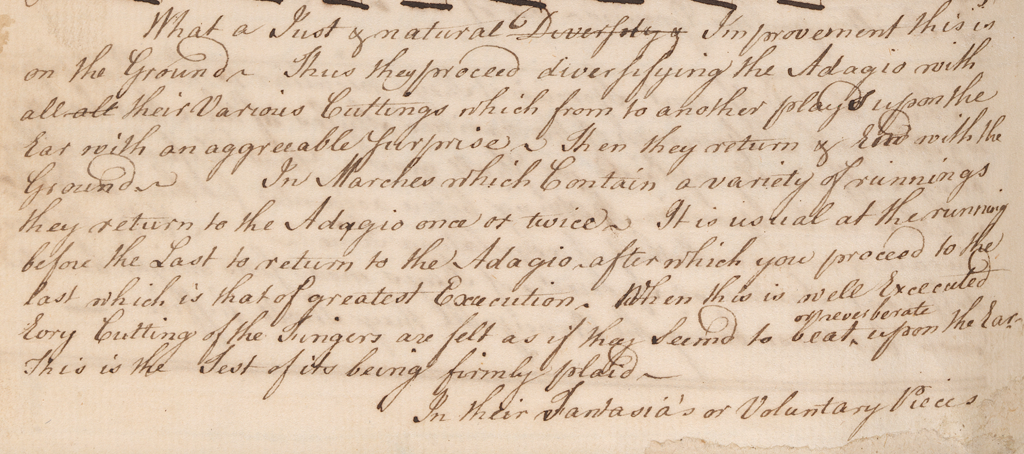[The admittedly provocative, but also tongue-in-cheek title, ‘we’re playing it wrong’, is meant to awaken our readership to these facts. After all the times other people have told me, ‘you are playing it wrong’, I thought it would be fun to turn the tables a bit. ]

A transcription:
…Thus they proceed diversifying the Adagio with all their Various Cuttings which from to another plays upon the Ear with an agreeable Surprise. Then they return or End with the Ground. In Marches which Contain a variety of runnings they return to the Adagio once or twice. It is usual at the running before the Last to return to the Adagio after which you proceed to the last which is that of greatest Execution. When this is well Executed Every Cutting of the Fingers are felt as if they Seem to beat or reverberate upon the Ear.
Enough has been said already on this subject in our Club. But I find it fascinating that despite all the other major edits Angus MacKay brought to pibroch, this one tradition was left intact: most of MacKay’s pibrochs consistently (if only) indicate a Da Capo al Thema just before the crunluath variation.
This suggests a real weight to the tradition, esp. when considered that competitions had already begun about 60 years before MacKay’s book was published.
In other words, the usual excuse for not playing Urlar returns is that the constraints of competitions forced them out. While this may be argued, it is clear that 3 generations after the first competition, Angus MacKay continues to record the presence of an Urlar refrain precisely where Joseph MacDonald indicates it 80 years before.
This tradition was that significant.

In my playing at home, I ‘run with the hares and hunt with the hounds’ by repeating the *first line* of the ground in Da Capo al Thema, rather than the entire ground.
I also repeat the first line of the ground after the crunluath doubling and THEN play the ‘a mach’ and stop (ie finishing the tune on the crunluath a mach, rather than yet another repeat of the urlar, or rather first line of the urlar). This is not justified in the old records, I realise. It’s what I like! :-)
In 1780, people did not have watches to send them off to work and other engagements… !
Two things here:
1) Several independent early records and the term a mach itself testify to finishing the tune on the Crunnludh A Mach. A Mach means ‘exit’ or ‘way out’, as you see on signs in buildings in Gaelic-speaking areas. What you like is incontrovertibly what they did.
2) The tempo at which you play a pibroch significantly affects its duration. I’m not suggesting that everything has slowed down, but that significant sections of the repertory appear to have done. Note these translations of siubhal: ‘Runnings, Variations, Allegro’ (J); ‘Variations Allegro Time’ (D1); ‘synonymous with allegro’ (KB).
Definitely, it completely changes the character of the music. It also puts a lot more weight on the urlar, and I think requires more thought to discover the song in the urlar rather than just treating it as another standalone abstract sequence.
Was the urlar played exactly the same each time it was repeated? Did the tempo change when it was repeated? Did the pipers tease out different aspects of the urlar as they played a repeat?
I suppose there may be historical notes about it somewhere, but I would venture to guess that anything we might say on this is pure conjecture.
And I’m not so sure it would be relevant.
I want to suggest that by re-extending the idiom, we are opening possibilities to modern performers, not trying to shoe-horn them back into a historical-reconstructionist straight-jacket.
(No one’s implying that. I’m just trying to be clear about my personal intentions.)
As a musician, knowing that an urlar refrain was so significant, choosing not to play it should give one pause to reflect upon why that choice is made. One can say, “Because nobody plays them anymore.” And that would be generally, true. But usually those folks who say that don’t really think about WHY it’s true, and for how long (or short) it has been true.
I want musicians to take responsibility for their choices, beginning in this case with why they are not playing it. Then when the choose to play it, I would like them to ponder upon how it should be played when repeated.
I know, for myself as I continue my years’ efforts at understanding the earliest “Too Long” version, I choose to keep it at the same tempo, and let the other variations swim around it. It’s working.
That’s how I think we should approach it.
The practice would create good places to pause to tune the drones as well.